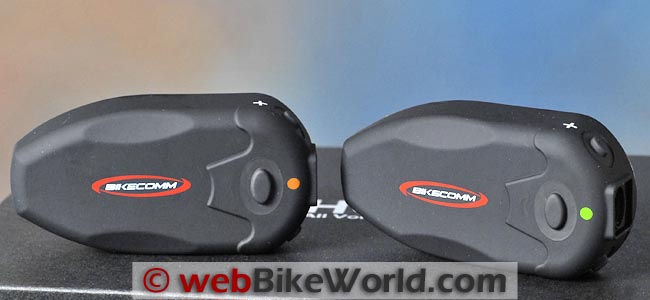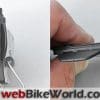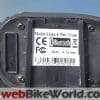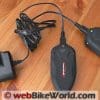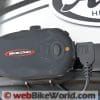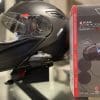The BikeComm Hola series motorcycle intercoms feature small Bluetooth modules with just three user buttons, standardized headset components and simple mounting options.
System configuration is simple and the intercoms are easy to use and the Hola intercoms can be quickly mounted on most motorcycle helmet types.
A specific focus for the Hola systems is the intercom feature. It works very well using either the Hola-S (rider-to-passenger) or longer-range Hola-F (rider-to-rider) versions.
This is aided in large part by an effective adjustable multi-level VOX feature that helps cope with noisy rider environments. The Hola intercoms are very fast, with virtually seamless device pairing, renewal and audio switching.
BikeComm provided the latest Hola systems after my original BikeComm BK-02 Group Intercom Part 1 review had been posted.
And other than where noted, this review is focused on the latest Hola systems running updated firmware.
The most recent firmware updates have vastly improved the performance of the original units, which were received in December of 2011. The output volume, clarity and microphone sensitivity have all been improved.
Using the Hola intercoms at high speeds in noisy environments is now realistic, albeit not quite on par with the latest Midland, Sena or Cardo offerings.
However, the BikComm systems are simple, robust, low cost and very functional products.
The Hola F-Pro Team (U.S.) retail package with upgraded speakers and enhanced boom and thin wire microphones, along with a rewritten English language guide, is an attractive option.
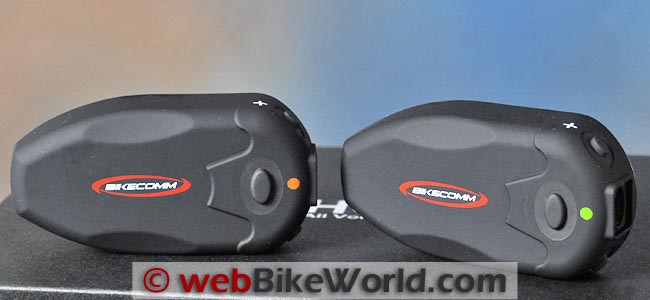
Background
When I say this evaluation is long overdue, I mean it. But in my defense there have been some extenuating circumstances that conspired to turn this into a long term effort over the winter, this spring and now the early part of summer.
Last December, while down south for some rest, recreation and riding, the BikeComm Hola S-10, F-10 and BikeComm BK-02 systems were all put into initial use, with initial observations recorded in the BikeComm BK-02 Group Intercom review.
Fast-forward to 2012, which resulted in some ongoing correspondence between OpenRoad Solutions, the Editor and myself that identified that ongoing hardware revisions were imminent, so the offer of the newly revised products was accepted.
Paralleling the hardware revisions, the continued development of the BikeComm Bluetooth Firmware Updater (BFU) application was also in process.
The BFU provides the means to download and install firmware updates to the BikeComm systems; something that has become a welcome capability of newer Bluetooth motorcycle communication products.
This BikeComm report is now split into two: the BikeComm BK-02 Group Intercom review and this three-part submission covering the BikeComm Hola-S (rider-to-passenger) and BikeComm Hola-F (rider-to-rider) intercom systems.
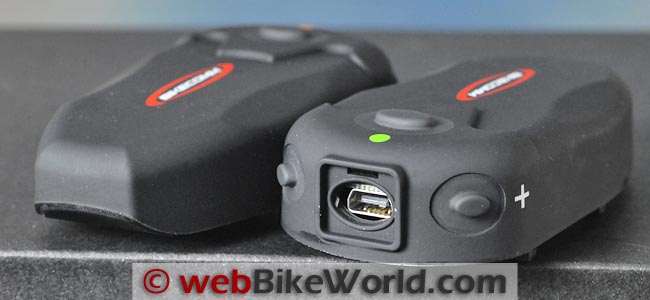
BikeComm Hola Features
The BikeComm Hola (Spanish for “hello”) is the most recent Bluetooth offering from Open Road Solutions.
Two versions of the Hola systems are marketed under the “clear voice is our obsession” logo stamped on each retail box: the Hola-S (rider with passenger) and the Hola-F (rider to passenger or rider to rider), with the latter having the longer-range intercom.
While the more comprehensive and multi-functional BikeComm BK02 (review) kit is markedly different, other than the use of the same Bluetooth module, the Hola intercom modules are physically identical.
And once removed from their box the only way to tell them apart is by the label on the back.
The basic component listing for the Hola kit includes:
- Two Bluetooth modules.
- Two Stereo headsets (the standard component has one connector for the microphone whereas the upgraded headset provides larger speakers and connectors for microphone and right speaker).
- Two spring clips and adhesive mounts; the new style “butterfly” mount is now provided.
- AC/DC power supply with dual mini-USB plugs.
- A useful bag of accessory items for a customized installation.
- User manual in Chinese and English (with English language/US market kits).
The newest kits we received are marked for the North American market and they have included the latest combination mount, the upgraded headset with heavier speakers and both the thin-wire and boom microphone components.
All of the Hola Bluetooth modules are compatible with the only real difference (or limitation) being intercom range, listed as 150 metres and 900 metres (+) for the S-10/F-Pro Single and F-10/F-Pro Team systems respectively.
Most of the major market players addressed product compatibility or the legacy issue some time ago and it is good to see BikeComm bring this feature to market with their systems.
However, the Hola systems are not compatible with the BikeComm BK-02 hub-based system, as that system includes a dedicated (locked) wireless link implementation for use with the Rider and Passenger headsets.
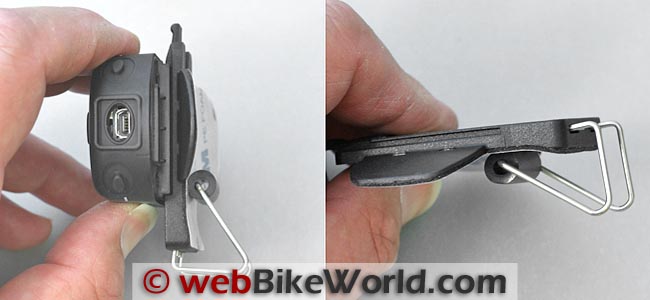
BikeComm Hola Helmet Installation
The “simple is better” theme embraced by the BikeComm team is certainly personified in their approach to helmet installation; installing a Hola intercom on virtually any type or make of helmet an easy thing to do.
Facilitating installation is the detachable lead for the microphone and with the latest headsets; another connector is provided for the right-side speaker of the stereo headset.
Many other manufacturers have or are adopting a more modular approach for all the right reasons, but for those who haven’t, including some big name players, my question is — why not?
At 21 cm (8.25 inches) long, the standard boom microphone component with a flat dual-piece adhesive mount went into all the open-face and modular style helmets on hand (or tried).
Some careful fitment also saw it work well in the Arai XD3 (review) helmet, although the lightweight thin-wire microphones received recently make full-face installation a breeze.
The standard speakers measure 22 cm (7/8″) in diameter with the hard plastic enclosures coming in at 30 mm x 35 mm and 10 mm thick with the hook backing.
The speaker in the upgraded larger speaker has a diameter of 30 cm, with a slightly larger housing. Both still fit without issue in helmets — including the oval recess found in SCHUBERTH helmets.
Repeating a mantra that bears repeating, it is imperative that the speakers or speakers be as close to the ear as possible so as to provide the best performance, which also means the volume control doesn’t have to be kept at maximum.
The accessory bag provided with all BikeComm kits provides everything needed for perfect placement.
The original Hola boxed kits provided a small mounting plate backed with 3M Dual Lock material and a small spring clip that got inserted into the bottom of the mounting plate to form either a clamp or pressure mount; simple but a bit cobby.
Mounting components in the new kits are very much improved. A small pliable butterfly-shaped plate does double-duty for both adhesive “stick-on” or clamp mount options.
The adhesive has an extremely strong bond to the helmet shell, or if the protective adhesive backing is not removed, the spring clip slips into the bottom holes for an instant clamp mount; another simple and effective improvement.
Contrasting with many other systems, all the BikeComm systems have a very small footprint and profile when mounted. As such they can be mounted above, below or around any low, mid or higher placed helmet controls, like sun visor sliders.
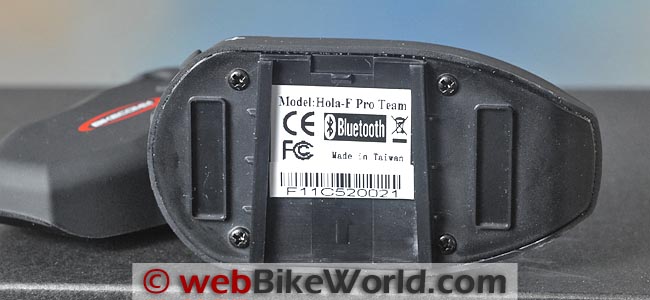
Learning the Hola System
I can’t resist a dig at the new Cardo Scala Rider G9 intercom (review) here… The G9 system is more advanced and more complex than most on the market, including the Hola systems.
But unless the owner is familiar with the Cardo Scala Rider G4 intercoms (review) or with standard motorcycle Bluetooth intercom system functions, the learning curve can be a wee bit exhaustive.
In the end, between a good manual and with some user effort, the results should be worth it.
In the next classroom, however, is the Hola 101 experience, which is much simpler, facilitated by a newly rewritten manual that is concise and easy to follow (for the most part).
After a quick read, and some practical one-on-one with the three simple controls of the Hola a great grade-point average is readily attainable.
BikeComm Hola Intercom System Management
As per normal industry practice, the internal Lithium-Ion battery is not replaceable but should survive a few hundred charge cycles.
Hola intercom modules are charged using the supplied AC/DC adapter that has dual mini-USB connectors for charging two systems at a time.
Trickle charging can be done by connecting modules to a USB 2 specification port on a PC or to other devices that provide USB-based power charging, like the 3BR USB (review) on-bike power outlets.
Charging the Hola systems before initial use took about 30 minutes for all modules, indicated by the Red to Green change in the LED.
On average, after a full day of use (steady music streaming and frequent intercom sessions), the “Battery Charge” voice notification status would still be over or at the 80 percent level; it takes two or sometimes three days of use to get the system below 50 percent.
The systems cannot (currently) be used while charging, but some email exchanges with the BikeCom representative provides a hint that this capability is being considered.
If so, this would add the Hola systems to the short list of motorcycle intercoms with this capability, currently including the Sena SMH10 (review) and Midland BT-Next (review) systems.
Generally speaking, charging during use has a lot of benefits regarding performance sustainment and eliminating the need to “touch up” the systems during breaks or when stopped for the night.
Some new motorcycles provide on-board USB outlets and many riders install accessory USB outlets or carry small inverters with a USB charging port.
All Hola systems can be firmware-updated using the USB interface and BikeComm Firmware Updater or BFU PC application (described below).
BikeComm has not yet publicly posted the software or instructions but webBikeWorld has been provided with the PC application and ongoing firmware updates as well as documentation revisions.
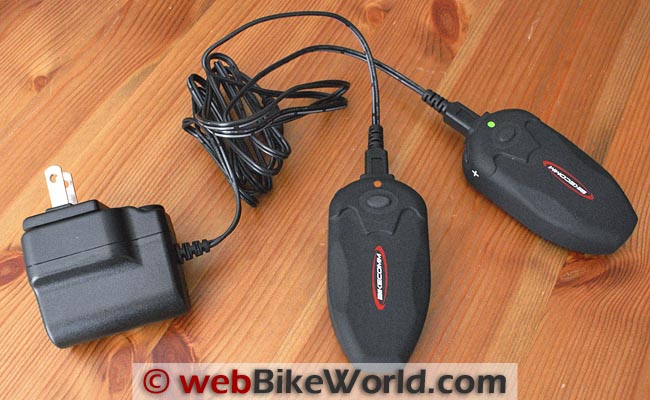


Buttons, Presses and Menu Choices
The three controls on the BikeComm Hola Bluetooth modules are a Main (multi) Function Button (aka MFB) on the face of the module, along with smaller Volume Up and Volume Down buttons at the rear.
These are located above and below the mini-USB connection port that serves as the headset connection and the means to charge and update the module.
The MFB provides the following capabilities:
- Power On: a one second push, with voice announcement of intercom mode.
- Power Off: three to five second push with voice battery status and firmware version announcements.
- Pairing: from off, an 8 to 10 second push initiates the Red/Blue pairing indicator.
- Phone Calls: press once to answer manually, three times to reject.
- Voice Dialing: if supported by phone, press once to initiate.
- Reconnection: if needed, press the MFB once quickly, connection will refresh.
Slightly higher than the smooth tactile skin of the module, the MFB is easy to feel with thin or medium-weight gloves but less so with cold weather gloves. But as the only control on the face, finding it ceases to be an issue after a day or so of use.
The top Volume Up button is readily accessible but the Volume Down button tucked under the 90-degree headset connector is less so.
I submitted this observation to the representative early on and a change is being made to eliminate the issue.
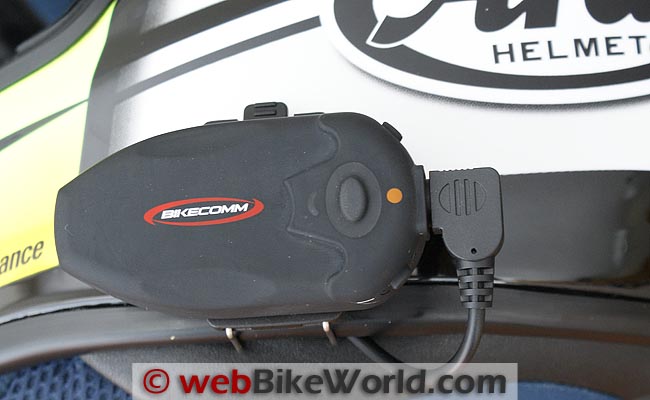


Hola Intercom Audio Management
Volume control on the Hola intercoms is provided manually using the V+ and V– buttons and automatically by the system. The volume of each discrete audio source can be adjusted, but to do so, that audio input must be active.
Once the choice is made, the respective settings for each source are retained by the system.
AVRCP: If supported by the paired device, pressing the [MFB] twice initiates Play/Pause; press [V-] twice for previous track; and, [V+] twice for next track: simple and reliable.
This feature works extremely well although the multi-functional nature of the three controls and timing of the presses sometimes brings about AVRCP action and sometimes system switching.
It all works but it takes a bit of time and use to get everything working smoothly.
AGC: The automatic volume increase or AGC feature on the Hola intercom comes into play when environmental noise levels increase.
But levels decrease to the original setting for the specific audio source once quieter conditions prevail such as when reducing speed, stopping or in sheltered areas.
VOX: Voice Activation or VOX in the Hola intercom can be used to initiate an intercom session, indicated by the double tone before the link opens. The system will end any session after ten seconds of silence (or when below threshold noise levels).
To compensate for differences in user-generated voice audio and noise levels, four VOX settings and one fixed mode are provided.
The discrete levels range from lowest input required to highest (level 1 to 4) with fixed (manual) mode equating to level 5. The settings are progressive in that higher VOX settings require more input volume (louder voice) to activate the intercom.
BikeComm performance testing completed provided the following VOX settings based on the following environment:
Honda ST1300 motorcycle with the rider wearing an open face Shoei J-Force helmet: Level 1: 0 to 90 km/h. Level 2: 0 to 120 km/h. Level 3: 0 to 150 km/h. Level 4: 0 to 170 km/h (plus).
Real world data collection is essential for this type of product, but my observation here is that using a single motorcycle environment (Honda ST1300) to determine VOX baseline settings represents a limited data set vis-à-vis multiple data sets that provide a broader base of scenarios.
Acknowledging the limitations noted above, I admit that the VOX capability in the Hola intercom systems works quite well under most conditions.
Although in a very noisy cockpit or helmet environment manual mode is the only viable option, as it is for many systems.
Adjusting the VOX feature is done with the system on but the intercom capability inactive. Pressing [V+] or [V-] twice rapidly moves the system Up or Down through each discrete step.
On Hola intercoms with the older firmware, single or and multiple tone sequences identified the VOX steps, but now the voice announcements provide very clear and well-modulated spoken status announcements.
Next: Part 2: BikeComm Hola Intercom Functionality
Owner Comments and Feedback
See details on submitting comments.
Owner Comments and Summary Table:
BikeComm Hola Review Part 3


